 |
 |
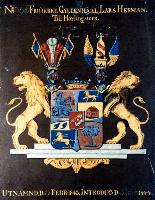 |
In Sweden, as elsewhere, people who performed heroic deeds, achieved something notable, or held prominent positions in government were sometimes rewarded by kings and queens with a noble title and the right to use a coat of arms. The basic design of the coat of arms is standard, consisting of a shield surmounted by a helmet, to which a crest is attached. (Crests were originally worn on the helmet during tournaments; they consisted of a panache of feathers attached to a wreath made of twisted strands, which was itself attached to the helmet by means of laces or rivets.) In some coats of arms a chapeau or crest coronet is used instead of a wreath to indicate rank. A mantling flows from beneath the crest; this protective cloth probably originated in the Holy Land where it was worn by crusading knights to keep the helmet from becoming unbearably hot. While all coats of arms conform to this basic arrangement, each is designed with differences to make it unique to the individual.
There are three Gyllenhaal coats of arms. We will examine them in the order in which they were granted.
The first Gyllenhaal coat of arms was granted to Nils Gunnesson Haal, a lieutenant in the Westgothia cavalry, when he was ennobled by Queen Christina on December 20th, 1652 after service in the Thirty Years War. According to the Knighthood Letter (adelsbrev) signed by Queen Christina, he served "first abroad and afterwards here within the country in the last Danish conflict, wherein he has conducted himself truly bravely and zealously." He was introduced at the House of Nobles twenty years later under the name Gyllenhaal (Nr 814).
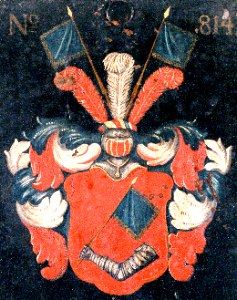 |
The form of the coat of arms is specified in the document as "a red shield, within it an armed arm holding upright a standard; above the shield a tilting helmet, the cover and the crown with blue, white and red divided; above on the helmet two standards of blue color in which are placed upright two red feathers and a white one between the two standards mentioned, precisely as it is here painted and reproduced with their proper colors." |
The coat of arms was given to Nils "and his legitimate descendants, male as well as female, those born as well as unborn," who may use it "in all noble and knightly matters, performances and festive gatherings, in the field, in battles, stormings, skirmishes, tournaments, titlings, reproductions, seals, and also on all other occasions in jest and in seriousness according to what seems best to him and them." The painting of the Gyllenhaal arms shown above still hangs in the Riddarhuset (House of Nobles). Painted on a copper plate, it was apparently nailed to the wall of the big meeting hall of the Riddarhuset on the day that the family was introduced to the House in 1672.
The second Gyllenhaal coat of arms was granted to Carl Henrik Gyllenhaal when he became the family's first friherre (baron) in 1837. He was introduced at the House of Nobles the following year (Nr 388). While it was usual for an heir to adopt the same heraldic device as his father, it was also necessary to distinguish his arms from those of other family relations. For this reason two or more coats could be placed on the same shield to signify inheritance, a marriage alliance, or the holding of a particular office. In the case of Carl Henrik's coat of arms, the original Gyllenhaal shield was retained in the center, but the rest of his shield was "quartered," as was usual with baronial coats of arms in Sweden. The four new coats in the shield contain his marital arms and arms of office. The crown above the shield is usual with baronial arms. [Note: the descriptions of the four coats with the shield below will follow heraldic convention by referring to the elements of the shield from the shieldholder's point of view (his left is your right).]:
|
Top Right: the coat of arms of Västergötland, as he had been
County Governor (landshövding) of Skaraborgs län. Top Left: the coat of arms of his first wife, baroness Hedvig Charlotta Rudbeck. Bottom Right: the coat of arms of his second wife, Beata Aurora af Nordin. Bottom Left: the coat of arms of Blekinge, as he had been County Governor of Blekinge län. |
The shield is surmounted by a crest coronet, above which is a mirrored letter C. These letters contain within them the Roman ciphers "XIV," a reference to King Carl XIV Johan, his great benefactor. (Carl Henrik was a close advisor to the King, and held the formal post of one of the Chamberlains of the Court.) Above the shield to the left is the Gyllenhaal family crest. The crest to the right of the coronet is crowned with an owl, the symbol of knowledge and wisdom; this may allude to Carl Henrik's position as one of the King's personal advisors.
There are two "supporters," one on each side of the shield. The green soldier refers to Carl Henrik's military service as captain of the Värmland Riflemen, and the horse refers to his post as colonel of the Jämtland Mounted Riflemen.
A motto in French is contained in a scroll above the crests: "Honneur, Candeur, Reconnaissance" (Honor, Candor, Gratitude).
The third Gyllenhaal coat of arms was granted to the Excellence Lars Herman Gyllenhaal. Lars Herman was a fourth cousin and contemporary of Carl Henrik, who was just two years his elder. It is believed that Carl Henrik advised the King to take his cousin Lars Herman into his service, and also to make him his principal minister (the justiestatsminister, or Prime Minister of Justice). He became the family's second friherre (baron) in 1843 on February 6, one month after he became justiestatsminister. He was introduced at the House of Nobles the following year (Nr 396).
|
Top Right: the Roman goddess of Justice, referring to his
association with the legal profession. Top Left: the coat of arms of his mother, Hedvig Margareta Leuhusen. The figures on her shield clearly allude to her maiden name Leuhusen, i.e. a lion and a house. Bottom Right: the coat of arms of his first wife, Henrika Lovisa Ulrika Tham (the significance of the horse and two wings on her shield is not apparent). Bottom Left: the coat of arms of his second wife Elisabet Sofia Palm. The figure of a palm tree on her shield refers to her maiden name, another example of allusive arms. |
The shield is surmounted by a crest coronet identical to the one above Carl Henrik's shield. To the left of the coronet is the familiar Gyllenhaal family crest. To the right of the coronet is a crest featuring secret masonic symbols. (Lars Herman was a high mason with the order of Karl XIII, an order created by that Monarch, the adoptive father of Carl XIV Johan, to further the cause of masonry in Sweden.)
The two lion "supporters" on either side of the shield may allude to the fact that the Excellence Lars Herman held one of the two highest offices in the Realm. Similar lion supporters are found on the Great Coat of Arms of the King of Sweden.
The various Gyllenhaal coats of arms have been reproduced in a variety of media over the years, including paintings, sculptures and jewelry. The Gyllenhaal Family Tree Project has been collecting photographs of these, and we would apprreciate hearing about any additional examples.
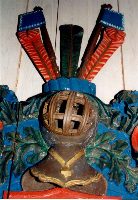 |
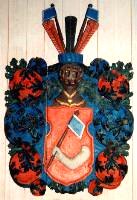 |
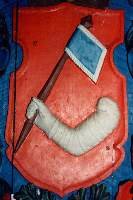 |
This "funeral coat of arms" or begravningsvapen hangs in the center of the north wall of the historic church in Bråttensby, Västergötland. The begravningsvapen were created for deceased noblemen and were made of painted wood, usually carved in relief. It was carried on a pole during the funeral procession, and was usually hung on an interior wall of the church after burial. Because the begravningsvapen was painted with the name of the deceased, and sometimes even the date of death, they are important today as historical documents as well as works of art. Many churches in Sweden have had them hanging on their walls for centuries. The Gyllenhaal example (Nr 814) is very large, carved in wood, and heavily repainted, but it still retains the proper heraldic colors. The plaque beneath it is inscribed for H. R. Gyllenhaal. Undoubtedly these initials refer to Hans Reinhold Gyllenhaal (1724-1796), Leonard's father. However, it is likely that it was originally made for Gudmund Gyllenhaal (1643-1700/01), the oldest son of Nils. Gudmund may be buried in the church cemetery. If this is the case, then the inscription on the plaque was probably repainted long after the death of Hans Reinhold by someone who was confused about the identity of the owner.
According to the church's pamphlet, when the building was renovated in 1898 several crypts were found beneath the flooring of the church. One of the crypts was made of oak planks and contained seven coffins; these are believed to belong to the Gyllenhaal-Wahlfelt family of Bråttensby manor (Wahlfelt was the surname of Leonard Gyllenhaal's mother). Hans Reinhold, Leonard's father, was supposedly found in one of the coffins. The family had come to Bråttensby manor (säteri) in the 1660s. It is known that in 1665 the owner was Gudmund, the son of Nils, who had been ennobled Gyllenhaal just a few years earlier in 1652. The family later lived at Ribbingsberg and Stora Höberg, respectively in Sodra Härene and Norra Vånga. It may never be known for sure whether this begravningsvapen was made for Gudmund, but it may be possible to arrive at a general date for the piece by stylistic comparisons.
| This gold signet ring with the Gyllenhaal coat of arms (Nr 814) carved into a carnelian intaglio is the only coat of arms to have survived in the American branch of the family. It was probably brought across the ocean by Anders Leonard Gyllenhaal when he emigrated from Sweden to America in 1866. The ring has been passed down from father to son ever since, and is now owned by Leonard Deane Gyllenhaal of Massachusetts. The goldsmith's marks reveal that it was made in Stockholm in the year 1768. A short article has been written about the ring, with additional photographs. |
|
This stamp seal with the Gyllenhaal coat of arms (Nr 814) bears the initials LHG (Lars Herman Gyllenhaal). It dates to the 18th or early 19th century. (The actual seal is in sunk relief, but here it has been turned into a positive image in raised relief.) |
| This stamp seal belonged to the Excellence Lars Herman Gyllenhaal. This is his baronial coat of arms (Nr 396). (The actual seal is in sunk relief, but here it has been turned into a positive image in raised relief.) |
|
This coat of arms is carved on a hunting rifle from Härlingstorp, the estate of the Excellence Lars Herman Gyllenhaal. It seems to be an adaptation of the baronial arms granted him in 1843 (see Nr 396 above). However, in this case the arm holding the standard is surmounted by an unusual crown above the shield. Comparison shows that this is not the baronial crown featured in Nr 396, but a different one, the significance of which is not clear. |
|
This large Gyllenhaal coat of arms (Nr 814) sculpted in wood was owned by Lars Herman Gyllenhaal (d. 1957), the grandson of the Excellence Lars Herman Gyllenhaal (d. 1865). Before that it was in the possession of Augusta Jakobina Charlotta Gyllenhaal (1833-1912), one of the daughters of Carl Henrik Gyllenhaal, who became the family's first friherre (baron) in 1837. A turn of the century photograph of Augusta's apartment shows the sculpture belonged to her at that time. She may have inherited it from her father. The Gyllenhaal Family Tree Project would appreciate any further information about the age and origin of this piece. |
| This Gyllenhaal coat of arms (Nr 814) was painted on a shield in the 1930s or 1940s for Lars Gunnar Fritz Gyllenhaal, a captain in Svea livgarde (the King's life guard). It was made for hanging at the West Point - Karlberg castle in Stockholm, as was the custom for all noble officers to do at the time. |
| Snuff-box made out of Swedish masur-birch with the Coat of Arms (Nr 388) of Carl Henrik Gyllenhaal, the Swedish Customs Director General and the first baron Gyllenhaal. |
The most frequently asked question on the Internet newsgroup rec.heraldry is: "My name is Smith (or Jones), what are my arms?" The short answer is this: "Your family probably has no coat of arms. Most families don't. Discovering whether your family has arms is a time-consuming problem in genealogy." The answer for Gyllenhaal descendants, however, is fairly straightforward, as the Gyllenhaal name is unique. Unlike people with the names Smith and Jones, all Gyllenhaals are related to each other.
In Sweden, after the revolution of 1809, a paragraph was added to the constitution specifying that only the eldest male heir should inherit noble titles. However, the constitution of 1809 affected only those who were ennobled after that date. Since the Gyllenhaal family (Nr 814) was ennobled before 1809, everyone who is born with (or is married to) the surname Gyllenhaal has the right to bear that coat of arms.
The two baronial coats of arms, however, were granted after the 1809 constitution, and are therefore more restricted in their use. The Excellence Lars Herman Gyllenhaal's 2nd great-grandson, also named Lars Herman Gyllenhaal
, holds the title friherre and is presently the only male in the family entitled to this baronial coat of arms (Nr 396). His wife Monica holds the title friherrinna (baroness), so she may also bear these arms. The baronial arms of Carl Henrik Gyllenhaal (Nr 388) are no longer in use; Carl Henrik's son died in 1910 without heirs, and that branch of the family has ended.